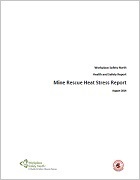Workplace Safety North / Ontario Mine Rescue
History

Ontario Mine Rescue was born out of the tragedy of the Hollinger Mine fire that claimed the lives of 39 miners in Timmins in 1928. Neither the mine, the town or even the province had the expertise or the resources to respond to save their lives or adequately fight the fire. Mine rescue teams from Pittsburgh had to be called in to extinguish the fire, while recovery operations were left to local mine management. The resulting provincial royal commission recommended the creation of an Ontario Mine Rescue organization under the Department of Mines to respond to underground mine fires. Over the past 80 years, Ontario Mine Rescue has evolved as lessons learned from mine rescue operations provided valuable insight for future endeavours.
The 1947 East Malartic Fire marked a major turning point for Ontario Mine Rescue as teams from Timmins, Kirkland Lake and Sudbury responded to a call to help fight a mine fire in Malartic, Que. It was the first and only time Ontario Mine Rescue teams responded to an out-of-province emergency. While working together, it became evident each district had different training and maintenance standards. As a result, the position of Senior Mine Rescue Officer was created to ensure province-wide standards in mine rescue training and equipment maintenance were established and maintained.
In 1965 another mine fire in Timmins, this one at the McIntyre Mine, forced the organization to make another change. The underground distance rescue teams had to travel to reach the fire was so great that the two-hour McCaa apparatus was not sufficient to allow them time to fight the fire. In 1966, after investigating and testing different apparatus, the BG174 was purchased to allow for a four-hour capability. The BG174 proved a workhorse for almost 40 years before it was replaced by the BG4.
Ontario Mine Rescue took on added responsibility in 1984 after four miners were trapped and killed in a rockburst at Falconbridge No. 5 Shaft near Sudbury. The Stevenson Commission recommended that the organization's mandate be expanded to conduct training in and respond to non-fire emergencies. Training on non-fire rescue equipment began shortly after.
In January 2001, responsibility for Ontario Mine Rescue was transferred to the Mines and Aggregates Safety and Health Association, now a part of Workplace Safety North (WSN). The program was modernized with state-of-the-art equipment including the Drager BG4 self-contained breathing apparatus. Standardized competency based training programs were developed to ensure consistent delivery of information to mine rescue teams across the province.
These and other developments have made Ontario Mine Rescue a role model for the establishment of training and safety programs for mine rescue organizations in other provinces and countries.
For more information, the historical, hardcover book Under Oxygen celebrates 75 years of mine rescue in Ontario.
Source: http://www.workplacesafetynorth.ca/subsite/mine-rescue/history

|
Join WSN. Make a difference.
At Workplace Safety North, we are dedicated to bringing every worker home safe and healthy.